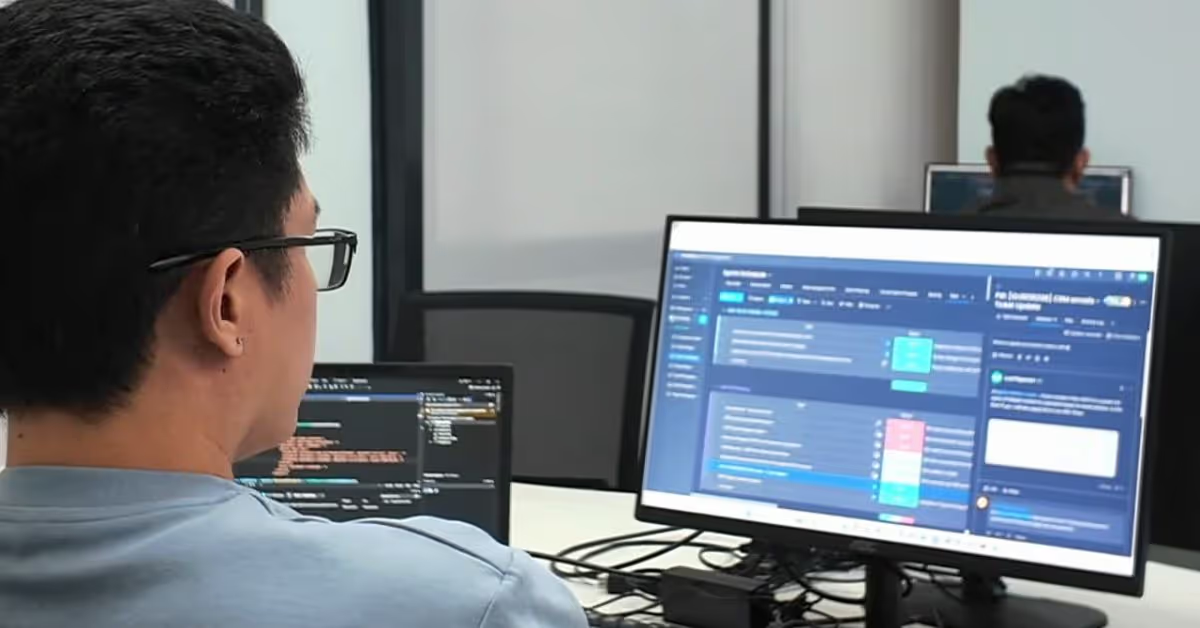Managing Distributed Teams: A CTO’s 2025 Playbook

📌 TL;DR
Managing distributed teams is now the norm for high-growth tech companies, not the exception. With engineering talent spread across regions, CTOs must master distributed leadership: balancing productivity, collaboration, culture, and well-being. Success depends on clear communication, timezone-smart workflows, cultural alignment, and trust-building.
Cloud Employee’s experience with 200+ nearshore and offshore developers offers actionable insights for CTOs and team leads. Done right, distributed teams extend capacity, speed up delivery, and give leaders access to top-class engineers worldwide, while keeping core teams focused on strategic priorities.
CTOs face intense delivery pressure: speed-to-market, talent shortages, and the need to scale fast. In 2025, the question isn’t whether to build distributed teams. The challenge is how to manage a distributed workforce effectively across borders and working hours. Leaders must ask: What does success look like in managing distributed tech and engineering teams now and in the future?
At Cloud Employee, we employee more than 200 nearshore and offshore developers, and more than 50 support staff. These distributed teams have delivered projects for startups and enterprises across time zones. Here are lessons from the field that show how to build trust, align goals, and lead successful distributed teams.
Defining Distributed Teams in 2025
Distributed teams are groups of professionals working remotely across regions and time zones. They aren’t just remote employees working from home. They operate as a connected workforce, collaborating daily with shared systems, workflows, and accountability.
For CTOs, distributed team management means balancing autonomy with alignment. Leaders must keep teams motivated, reinforce common goals, and manage a distributed environment with effective communication.
Why Distributed Team Management Matters Now
Several global shifts make leadership in distributed teams more important than ever:
- Talent shortages: Gartner’s 2024 IT talent report notes that 64% of leaders rank talent scarcity as their biggest risk.
- Global hiring models: Distributed team leadership helps CTOs reach talent in LATAM and Southeast Asia, with Cloud Employee offering 50–75% cost efficiency compared to US/UK hiring. Explore our price comparison here.
- AI-driven development: AI tools demand strong collaboration structures to avoid silos.
- Hybrid collaboration: Offices exist, but working remotely is the default, making structured management essential.
Benefits of Managing Distributed Teams Well
- Access global talent – CTOs can close skill gaps fast.
- Faster hiring – Cloud Employee helps clients onboard in weeks, not months.
- Cost efficiency – Example: A US W2 developer costs $18,056/month; in the Philippines with Cloud Employee, it’s $4,500/month all-inclusive (HR, L&D, benefits, compliance, retention, and more).
- Resilience – Distributed workforce models reduce single-point risks.
- Focus on strategy – Core teams stay motivated and concentrate on strategic planning while remote workers extend delivery capacity.
Challenges and Lessons Learned
Distributed team leadership comes with unique challenges:
- Time zones: Without overlap, delivery slows.
- Cultural differences: Miscommunication grows if leaders ignore norms.
- Burnout: Long working hours or poor boundaries exhaust remote employees.
- Accountability gaps: Without transparent metrics, performance tracking fails.
Cloud Employee addresses these by:
- Vetting engineers with CTO led pair-programming to ensure technical and cultural fit.
- Structuring timezone overlap - All CE developers can work completely in line with client's normal operating hours
- Maintaining 97% retention beyond 2 years by supporting career growth, through dedicated L&D and Employee Experience teams.
- Offering rolling contracts with transparent terms.
Channels, Tools, and Red Flags
Distributed team communication strategies rely on multiple channels
- Messaging: Slack and Microsoft Teams for fast communication.
- Video calls: Zoom for standups, retrospectives, and one-to-one check-ins.
- Collaboration: Jira and Trello for backlog tracking; Notion and Confluence for documentation; Miro for workshops.
- Engineering: GitHub and GitLab for code management; CircleCI for pipelines.
- Engagement: 15Five and Lattice for feedback and knowledge sharing.
Signals that systems are failing, or not optimal
CTO Anto of Cloud Employee shares three signs:
- Silos form in chats – When remote employees rely on private channels, team collaboration breaks down.
- Too many video calls – Managers use meetings to compensate for unclear processes.
- Falling velocity – Missed sprints suggest ineffective communication or poor accountability.
Embedding a Remote-First Culture
Successful distributed team leadership starts with culture, not tools. Leaders must design communication and workflows for working remotely as the norm.
Where to start:
- Set norms – Default to async updates and clear documentation before scheduling calls.
- Be transparent – Publish sprint goals, decisions, and blockers in shared spaces.
- Onboard well – Teach remote-first habits, including knowledge sharing, early.
- Lead by example – Executives must practice the behaviors they expect.
- Measure outcomes – Use velocity, cycle times, and engagement surveys to track effectiveness.
A Deloitte 2024 study found distributed teams with strong communication systems delivered 22% more productivity and had 31% lower attrition than those without. Culture is not optional; it’s a performance driver.
As Anto explains:
Distributed leadership fails not because of distance but because leaders neglect culture. You must design culture as deliberately as your tech stack.
Best Practices for CTOs
- Define communication rules – Clarify async vs sync and encourage team members to document decisions.
- Prioritize culture – Introduce remote workers to company culture and common goals from day one.
- Design for time zones – Plan workflows to minimize blockers and overlap hours effectively.
- Choose tools wisely – Slack, Jira, GitHub, Notion, and Miro should be core.
- Measure results – Track delivery, not working hours.
- Avoid burnout – Protect social interactions, rotate duties, and encourage downtime.
- Build trust – Recognize achievements, provide feedback, and align goals.
In 2025, managing distributed software development teams is a strategic skill for CTOs. Poorly managed teams face misalignment and burnout. Well-managed teams unlock talent, speed up delivery, and strengthen resilience.
Cloud Employee’s work with 200+ nearshore and offshore developers shows the potential: faster hiring, higher retention, and measurable cost efficiency.
Ready to manage a distributed team with top-class engineers? See how Cloud Employee works.
FAQs
By creating effective communication, setting common goals, and leading with transparency.
Use async workflows, set core hours, and keep backlogs visible.
Slack, Jira, GitHub, Notion, and Miro support collaboration and knowledge sharing.
Give remote employees structured onboarding, pair mentoring, and clear cultural guidelines.
Manage working hours, protect downtime, and encourage team members to balance workloads.






